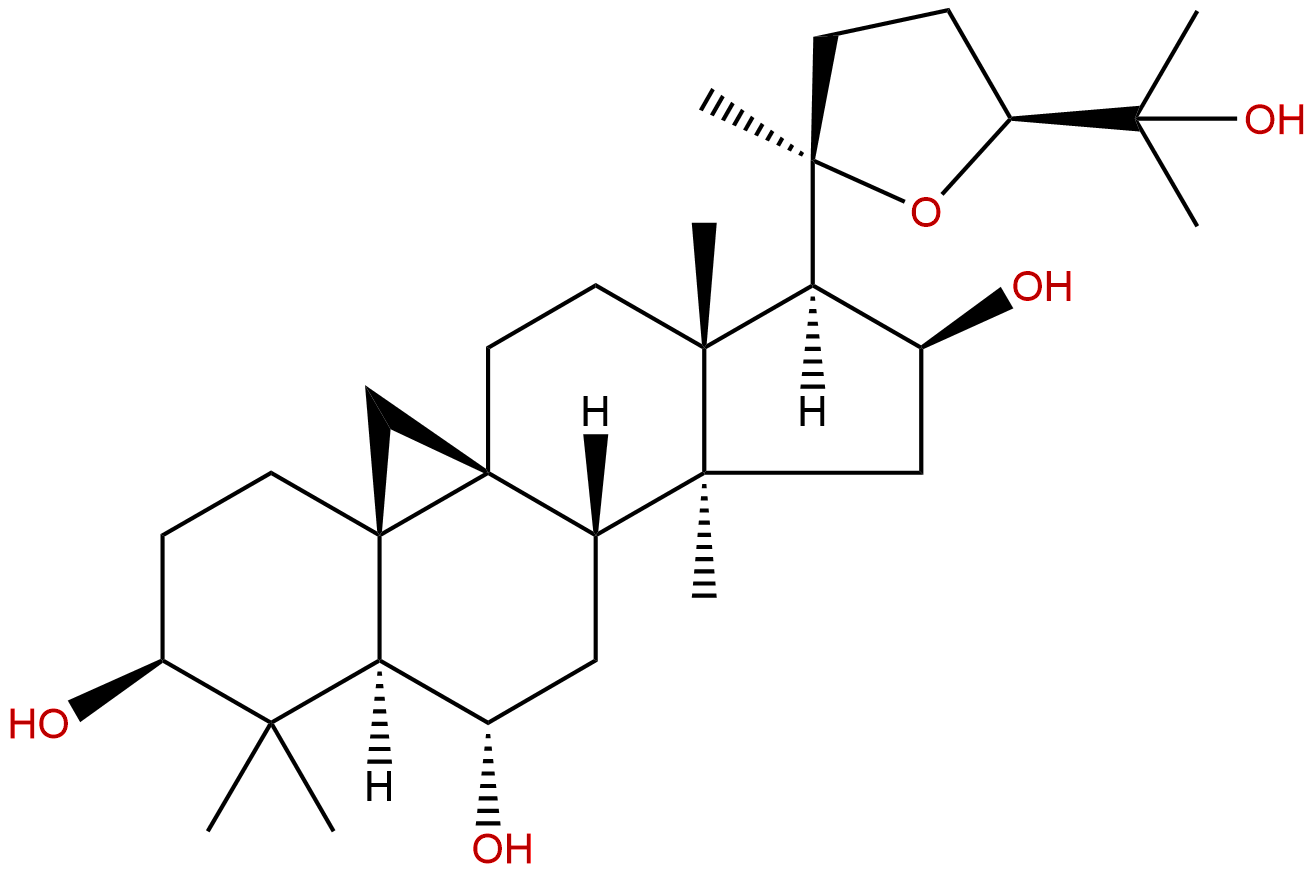
CyclogalegenolCAS No.:78574-94-4
|
||||||||||
 |
|
|
||||||||

| Catalogue No.: | BP0434 |
| Formula: | C30H50O5 |
| Mol Weight: | 490.725 |
Product name: Cyclogalegenol
Synonym name: Astramembrangenin; Cyclosieversigenin; Cyclosiversigenin
Catalogue No.: BP0434
Cas No.: 78574-94-4
Formula: C30H50O5
Mol Weight: 490.725
Botanical Source: Sapogenin from Astragalus galegiformis
Physical Description: Cryst.
Type of Compound: Triterpenoids
Purity: 95%~99%
Analysis Method: HPLC-DAD or/and HPLC-ELSD
Identification Method: Mass, NMR
Packing: Brown vial or HDPE plastic bottle
Storage: Store in a well closed container, protected from air and light. Put into refrigerate or freeze for long term storage.
Whenever possible, you should prepare and use solutions on the same day. However, if you need to make up stock solutions in advance, we recommend that you store the solution as aliquots in tightly sealed vials at -20℃. Generally, these will be useable for up to two weeks.
The product could be supplied from milligrams to grams, up to kilograms
Inquire for bulk scale.
Descriptions:
Cycloastragenol(CAG), a triterpene aglycone derived from Radix astragali , can suppress the accumulation of cytoplasmic lipid droplet in 3T3-L1 adipocytes.[1]
Two Chinese herb-derived small molecule telomerase activators, astragaloside IV (AG-IV) and cycloastragenol, have recently been shown to improve the proliferative response of CD8+ T lymphocytes from HIV-infected patients by upregulating telomerase activity, they also may exert their cellular effects through the activation of the Src/MEK/ERK pathway.[2]
Cycloastragenol is the aglycone derivative of astragaloside IV which has recently been demonstrated to activate telomerase and represents a potential drug candidate for the treatment of degenerative diseases, it is efficiently absorbed through intestinal epithelium; it moderately increases telomerase activity and proliferative capacity of both CD4 and CD8 T cells. [3,4]
Cycloastragenol and astragaloside IV suppress ROS-associated ER stress and then inhibited TXNIP/NLRP3 inflammasome activation with regulation of AMPK activity, and thereby ameliorated endothelial dysfunction by inhibiting inflammation and reducing cell apoptosis, they are equally effective in regulation of endothelial homeostasis.[5]
Cycloastragenol can remarkably inhibit CYP3A4 and activate CYP2E1 in rats.[6]
Cycloastragenol has been shown to extend T cell proliferation by increasing telomarase activity showing that it may also help delay the onset of cellular aging ; it is an extraordinary wound healing agent; it inhibits the apoptosis of PC12 induced by 6-OHDA, may be as potential neuroprotective agents in the treatment of Parkinson's disease. [7]
References:
[1] Wang S, Zhai C, Liu Q, et al. Biochem Bioph Res Co, 2014, 450(1):306-11.
[2] Yung L Y, Lam W S, Ho M K, et al. Planta Med, 2011, 78(2):115-21.
[3] Zhu J, Lee S, Ho M K C, et al. Drug Metab Pharmacok, 2010, 25(5):477-86.
[4] Valenzuela H F, Fuller T, Edwards J, et al. J Immunol, 2009, 182.
[5] Yan Z, Qiang L, Zhao W, et al.J Ethnopharmacol, 2015, 169(20):210-8.
[6] Wei B H, Jing Y E, Xue B J, et al. Chinese Journal of New Drugs, 2014, 23(4):476-9.
[7] Nesil T, ürkmez A ?, Bedir E. Planta Med, 2011, 77(12):1444.
[8] Wang J S. Strait Pharmacy, 2009, 21 (2): 39-41.
HPLC of Cyclogalegenol
